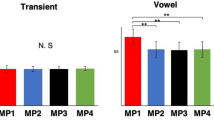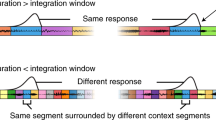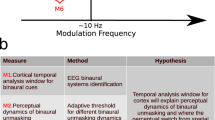Abstract
We measured the neural activity associated with the temporal structure of sound in the human auditory pathway from cochlear nucleus to cortex. The temporal structure includes regularities at the millisecond level and pitch sequences at the hundreds-of-milliseconds level. Functional magnetic resonance imaging (fMRI) of the whole brain with cardiac triggering allowed simultaneous observation of activity in the brainstem, thalamus and cerebrum. This work shows that the process of recoding temporal patterns into a more stable form begins as early as the cochlear nucleus and continues up to auditory cortex.
This is a preview of subscription content, access via your institution
Access options
Subscribe to this journal
Receive 12 print issues and online access
$209.00 per year
only $17.42 per issue
Buy this article
- Purchase on Springer Link
- Instant access to full article PDF
Prices may be subject to local taxes which are calculated during checkout



Similar content being viewed by others
References
Nobili, R., Mammano, F. & Ashmore, J. How well do we understand the cochlea? Trends Neurosci. 21, 159–167 (1998).
Rose, J. E., Brugge, J. F., Anderson, D. J. & Hind, J. E. Phase-locked response to low-frequency tones in single auditory nerve fibres of the squirrel monkey. J. Neurophysiol. 30, 769–793 (1967).
Rouilly, E., deRibaupierre, Y. & deRibaupierre, F. Phase-locked responses to low frequency tones in the medial geniculate body. Hear. Res. 1, 213–226 (1979).
Yost, W. A., Patterson, R. D. & Sheft, S. A time domain description for the pitch strength of iterated rippled noise. J. Acoust. Soc. Am. 99, 1066–1078 (1996).
Patterson, R. D., Yost, W. A., Handel, S. & Datta, A. J. The perceptual tone/noise ratio of merged iterated rippled noises. J. Acoust. Soc. Am. 107, 1578–1588 (2000).
Patterson, R. D., Anderson, T. & Allerhand, M. in Proceedings of the International Conference on Spoken Language Processing 1994, 1395–1398 (Yokohama, Japan, 1994).
Langner, G. Periodicity encoding in the auditory system. Hear. Res. 60, 115–142 (1992).
Patterson, R. D., Allerhand, M. H. & Giguère, C. Time-domain modeling of peripheral auditory processing: a modular architecture and a software platform. J. Acoust. Soc. Am. 98, 1890–1894 (1995).
Langner, G. & Schreiner, C. E. Periodicity coding in the inferior colliculus of the cat. I. Neuronal mechanisms. J. Neurophysiol. 60, 1799–1822 (1988).
Moore, J. K. T. in Neurotology (eds. Jackier, R. K. & Brackmann, D. E.) 1–17 (Mosby, St. Louis, 1994).
Griffiths, T. D., Buechel, C., Frackowiak, R. S. J. & Patterson, R. D. Analysis of temporal structure in sound by the human brain. Nat. Neurosci. 1, 421–427 (1998).
Guimares, A. R. et al. Imaging subcortical activity in humans. Hum. Brain. Mapp. 6, 33–41 (1998).
Hall, D. A. et al. “Sparse” temporal sampling in auditory fMRI. Hum. Brain. Mapp. 7, 213–223 (1999).
Rees, G., Friston, K. & Koch, C. A direct quantitative relationship between the functional properties of human and macaque V5. Nat. Neurosci. 3, 716–723 (2000).
Wiegrebe, L. & Winter, I. M. Temporal representation of iterated rippled noise as a function of delay and sound level in the ventral cochlear nucleus. J. Neurophysiol. 85, 1206–1219 (2001).
Chawla, D., Lumer, E. D. & Friston, K. J. The relationship between synchronization among neuronal populations and their mean activity levels. Neural Comput. 11, 1389–411 (1999).
Rauschecker, J. P., Tian, B. & Hauser, M. Processing of complex sounds in the macaque nonprimary auditory cortex. Science 268, 111–114 (1995).
Zatorre, R. J., Evans, A. C. & Meyer, E. Neural mechanisms underlying melodic perception and memory for pitch. J. Neurosci. 14, 1908–1919 (1994).
Griffiths, T. D., Johnsrude, I., Dean, J. L. & Green, G. G. R. A common neural substrate for the analysis of pitch and duration pattern in segmented sound? Neuroreport 18, 3825–3830 (1999).
Patterson, R. D., Handel, S., Yost, W. A. & Datta, A. J. The relative strength of the tone and the noise components in iterated rippled noise. J. Acoust. Soc. Am. 100, 3286–3294 (1996).
Duvernoy, H. M. The Human Brain (Springer, New York, 1999).
Author information
Authors and Affiliations
Corresponding author
Supplementary information
Rights and permissions
About this article
Cite this article
Griffiths, T., Uppenkamp, S., Johnsrude, I. et al. Encoding of the temporal regularity of sound in the human brainstem. Nat Neurosci 4, 633–637 (2001). https://doi.org/10.1038/88459
Received:
Accepted:
Issue Date:
DOI: https://doi.org/10.1038/88459
This article is cited by
-
Categorical processing of fast temporal sequences in the guinea pig auditory brainstem
Communications Biology (2019)
-
Auditory functional magnetic resonance imaging in dogs – normalization and group analysis and the processing of pitch in the canine auditory pathways
BMC Veterinary Research (2016)
-
Tuning to Binaural Cues in Human Auditory Cortex
Journal of the Association for Research in Otolaryngology (2016)
-
Hierarchical Neural Encoding of Temporal Regularity in the Human Auditory Cortex
Brain Topography (2015)
-
Functional magnetic resonance imaging of the ascending stages of the auditory system in dogs
BMC Veterinary Research (2013)



